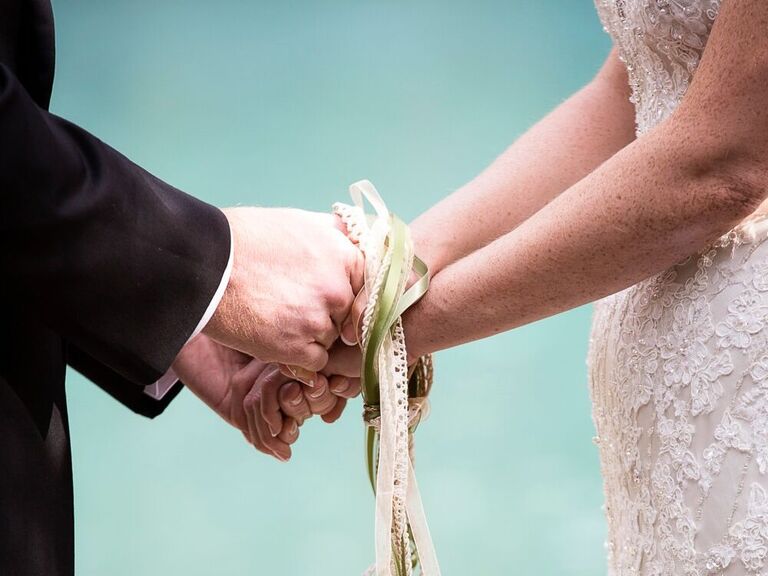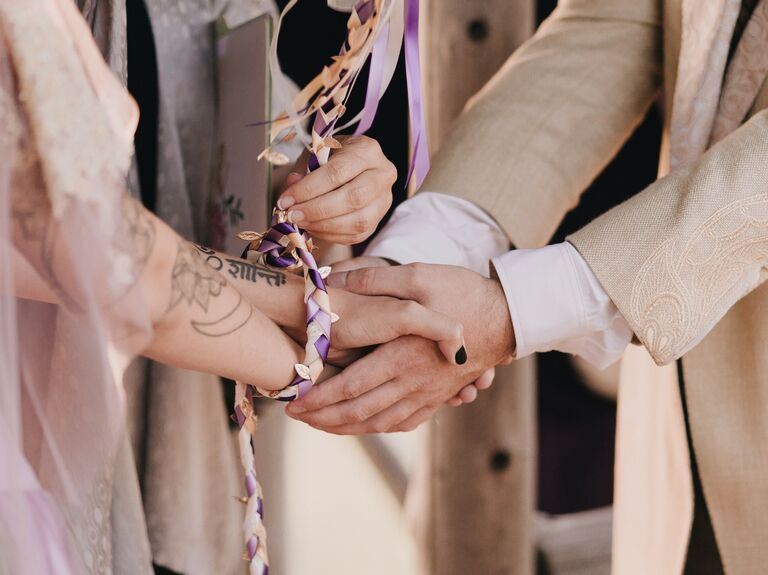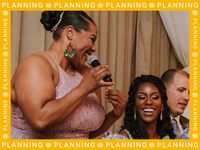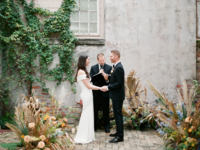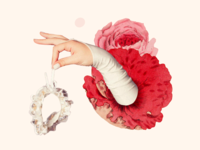The History of the Handfasting Ceremony and How to Include the Ritual at Your Wedding
The handfasting ceremony is a centuries-old wedding tradition steeped in symbolism and significance. And while it's not a substitute for legal marriage, it's a common unity ceremony ritual that many couples choose to incorporate as a special addition to their vows. By using carefully-selected cords of various colors that represent different promises to one another, couples begin the start of their married life—quite literally—tied together. Interested in including a handfasting ceremony on your wedding day? Here's everything you need to know.
In this article:
- What Is a Handfasting Ceremony?
- Handfast Ceremony Meaning
- Handfast Ceremony History
- How to Perform a Handfasting Ceremony
- Handfasting Ceremony Script
- How Long Should a Handfasting Ceremony Last?
- Handfasting Cord Color Meanings
- What Are Handfasting Cords Made Of?
What Is a Handfasting Ceremony?
A wedding handfasting ceremony is a symbolic unity ritual signifying that the couple is joining together as one. The tradition involves temporarily wrapping or tying the couple's hands together using ribbons, ropes or cloth.
The definition of handfasting comes from its Middle English roots as a quick marriage ceremony. Centuries ago, the couple's hands would be joined—either by being wrapped in a cloth or simply with fingers intertwined—and after a few words were spoken (this is where the 'fast' part comes in), they would be betrothed.
Is a handfasting ceremony a legal marriage?
In the United States, performing a handfasting ceremony is purely symbolic and is not considered a legal marriage. You'll still need to hire a wedding officiant who's legally qualified or ordained to perform marriages in your state, as well as file an official marriage license prior to your wedding date.
Handfast Ceremony Meaning
The handfasting ceremony symbolizes the couple's love and commitment to each other, as well as their two lives merging into one. Centuries ago, handfasting was performed as a placeholder for the legal wedding ceremony, because it was often more difficult to find a priest in rural villages or travel several days to reach a house of worship. So what's the difference between wedding vows and handfasting? They're two important—but different—ceremony traditions. Handfasting is an optional ritual that can be performed with or without an officiant. Reciting your vows and exchanging wedding rings is usually considered to be the "official" moment that you become married, witnessed by someone who's legally ordained.
Handfast Ceremony History
Originating in Scotland in the 16th or 17th century, a handfasting ceremony was a way to make a contract with your beloved. Handfasting was considered an important part of any Celtic wedding, and the Scottish term roughly translates into, "to strike a bargain by joining hands." The ritual is historically part of all Pagan and Wiccan celebrations, dating back hundreds of years, but it also has origins in Norse wedding traditions and Irish ceremonies.
Oleta Collins, a handfasting expert and wedding florist at Flourishing Art Design Studio in Bakersfield, California, explains that when the custom first originated, couples were encouraged to wear the ribbon for a year and a day, and then decide if they would like to stay married. Couples would keep the ribbons on for months at a time or however long it took them to find a minister or priest to perform the legal ceremony. If they wanted to separate, it would be as if they were never married—sort of like a trial marriage rather than a traditional wedding.
How to Perform a Handfasting Ceremony
Did you know that the term 'tie the knot' actually originates from the traditional handfasting ceremony? There's no right or wrong way to perform the ritual, but this step-by-step guide will give you the general idea.
1. Choose your cords or fabric.
We'll share more on this in a minute, but the first step in your handfasting ceremony is deciding what type of cloth, ribbons or ropes you want to use. You can opt for something simple and understated, like a plain white rope, or have handfasting ribbons custom-made with special embroidery, charms or other details.
2. Decide how you want to tie knots or fasten the cords.
If you're worried about how to tie handfasting cords, rest assured that there's not a specific right or wrong way to do it. The most important thing is that your hands are closely held together and that the cords are securely wrapped or tied. The officiant will generally tie the knots or wrap the couple's hands together, but you can also do this yourselves—it all depends on how symbolic you want the ceremony to be. "There are several ways to wrap the hands during the ceremony. It can be as simple as wrapping around a single knot to tying them into a stunning infinity knot," says Collins. "Your officiant should be able to help you decide which is best for you."


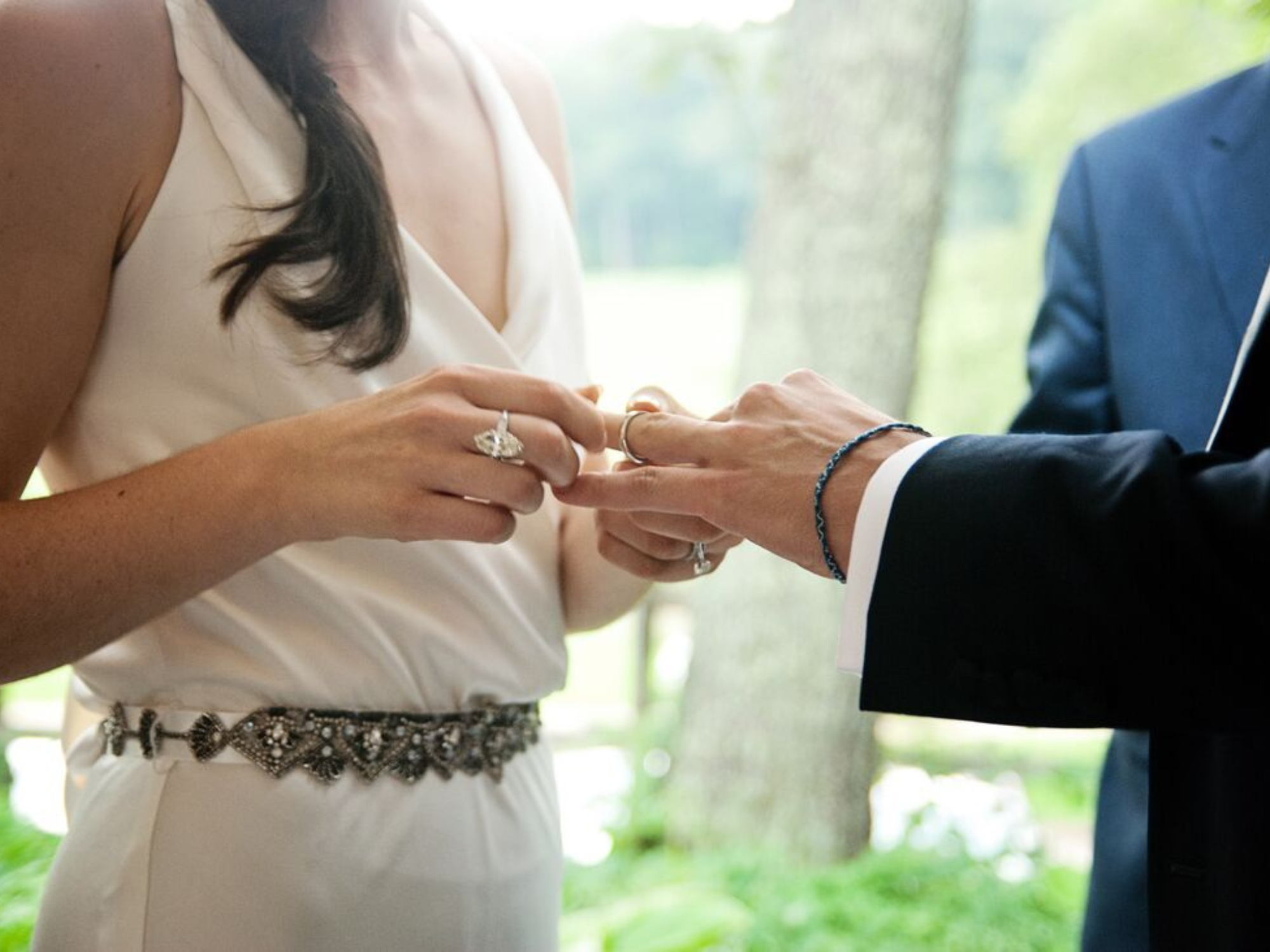
Bethel Nathan, an ordained wedding officiant based in southern California, says that many couples actually choose to tie their own knot. In some cases, couples don't use a knot at all, but rather wrap a single, long ribbon or cord around their joined hands. Nathan also suggests the idea of involving important people, like parents, to help wrap the ribbons or cords around your joined arms.
3. Leave the cords on for your chosen length of time.
Following the tying of the knot, couples may choose to leave the cords on for the remainder of their ceremony, or remove their hands after the brief words are spoken and continue with the service.
Handfasting Ceremony Script
What's beautiful about the handfasting ceremony is how it welcomes all couples: religious and non-religious, LGBTQ+ and everyone in between. As Nathan explains, everyone chooses different handfasting vows during this special moment, and people will decide to have a handfasting ceremony at various points of the wedding ceremony, depending on what makes the most sense for their needs. "In my ceremonies, it goes either right before their personal vows or in place of vows. Some officials do it at the end, but I like doing it combined amongst the vows and rings at the core of the ceremony," Nathan says.
You can share yourhandwritten vows as part of the handfasting ceremony, or you can recite a few other meaningful sentences that sum up your bond. If your officiant is performing the wrapping, they can explain the significance of the handfasting cords to the crowd. Try an adaptation of this sample handfasting vows script: "[Spouse name], take these cords as a symbol of my devotion to you. With each wrapping [or tying of the knot], my promise to you grows deeper and stronger. May these cords symbolize our eternal love and our lives forever intertwined, and may they never unravel."
How Long Should a Handfasting Ceremony Last?
Because the handfasting ritual is so personal to your own ceremony, you decide how long it should be. If you choose to incorporate your wedding vows throughout the experience, it will likely last around 10 minutes, Nathan estimates. If you're simply wrapping the cords or tying knots, it will be a shorter ritual, around two or three minutes.
Handfasting Cord Color Meanings
In terms of handfasting history, Nathan says there are common colors and meanings associated with the cords, but some couples will give different meanings based on their own relationship. For example, if the color purple was your mom's favorite hue, you could choose that one as a special way to honor her. But how many cords should you pick for your handfasting? A handful—or should we say, an armful? "My couples, if they choose to have the color of the cords included in the ceremony, usually pick one or two or maybe three meanings per color, not all of them," says Collins. Here are some of the most popular handfasting cord color meanings.
- Red: passion, strength, lust, fertility
- Orange: encouragement, attraction, kindness, bounty
- Yellow: charm, confidence, joy, balance
- Green: finances, fertility, charity, prosperity, health
- Blue: tranquility, patience, devotion, sincerity
- Purple: Power, piety, sanctity, sentimentality
- Black: strength, wisdom, vision, success
- White: purity, concentration, meditation, peace
- Gray: neutrality, canceling, balance
- Pink: unity, honor, truth, romance, happiness
- Brown: earth, grounding, talent, telepathy, home
- Silver: treasure, values, creativity, inspiration
- Gold: energy, wealth, intelligence, longevity
What Are Handfasting Cords Made Of?
Traditionally, Collins says cords for handfasting are created out of elastic material that is woven together with other colors and then tied. For something more personal, you can customize your handfasting cords and change the material to lace, ribbon or a combination of different materials. Collins says some choose to add Celtic knots, gold leaves, entwined trees, or other meaningful symbols. "We have seen some newlyweds use fabric that is handed down in their families to have a more personalized experience," she adds. Ultimately, you want your handfasting cords to be somewhat durable—after all, the point is to keep them unraveling for years (or decades) to come, especially if you're planning to pass the cords onto other loved ones after your wedding day.
